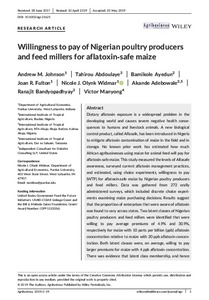| dc.contributor.author | Johnson, A.M. |
| dc.contributor.author | Abdoulaye, T. |
| dc.contributor.author | Ayedun, B. |
| dc.contributor.author | Fulton, J.R. |
| dc.contributor.author | Widmar, N.J.O. |
| dc.contributor.author | Akande, A. |
| dc.contributor.author | Bandyopadhyay, R. |
| dc.contributor.author | Manyong, V. |
| dc.date.accessioned | 2019-12-04T11:36:53Z |
| dc.date.available | 2019-12-04T11:36:53Z |
| dc.date.issued | 2019-07-09 |
| dc.identifier.citation | Johnson, A.M., Abdoulaye, T., Ayedun, B., Fulton, J.R., Widmar, N.J.O., Adebowale, A., ... & Manyong, V. (2019). Willingness to pay of Nigerian poultry producers and feed millers for aflatoxin‐safe maize. Agribusiness, 1-19. |
| dc.identifier.issn | 0742-4477 |
| dc.identifier.uri | https://hdl.handle.net/20.500.12478/6376 |
| dc.description | Open Access Article |
| dc.description.abstract | Dietary aflatoxin exposure is a widespread problem in the developing world and causes severe negative health consequences to humans and livestock animals. A new biological control product, called Aflasafe, has been introduced in Nigeria to mitigate aflatoxin contamination of maize in the field and in storage. No known prior work has estimated how much African agribusinesses using maize for animal feed will pay for aflatoxin‐safe maize. This study measured the levels of Aflasafe awareness, surveyed current aflatoxin management practices, and estimated, using choice experiments, willingness to pay (WTP) for aflatoxin‐safe maize by Nigerian poultry producers and feed millers. Data was gathered from 272 orally administered surveys, which included discrete choice experiments examining maize purchasing decisions. Results suggest that the proportion of enterprises that were aware of aflatoxin was found to vary across states. Two latent classes of Nigerian poultry producers and feed millers were identified that were willing to pay average premiums of 4.9% and 30.9%, respectively for maize with 10 parts per billion (ppb) aflatoxin concentration relative to maize with 20 ppb aflatoxin concentration. Both latent classes were, on average, willing to pay larger premiums for maize with 4 ppb aflatoxin concentration. There was evidence that latent class membership, and hence WTP, varied based on awareness of aflatoxin and across geographies. |
| dc.description.sponsorship | United States Government Feed the Future Initiative’s USAID‐CGIAR |
| dc.description.sponsorship | Bill & Melinda Gates Foundation |
| dc.format.extent | 1-19 |
| dc.language.iso | en |
| dc.rights | CC-BY-4.0 |
| dc.subject | Aflatoxins |
| dc.subject | Poultry |
| dc.subject | Farmers |
| dc.subject | Maize |
| dc.subject | Livestock |
| dc.subject | Animals |
| dc.title | Willingness to pay of Nigerian poultry producers and feed millers for aflatoxin‐safe maize |
| dc.type | Journal Article |
| dc.description.version | Peer Review |
| cg.contributor.crp | Agriculture for Nutrition and Health |
| cg.contributor.crp | Maize |
| cg.contributor.crp | Policies, Institutions and Markets |
| cg.contributor.crp | Roots, Tubers and Bananas |
| cg.contributor.affiliation | Purdue University |
| cg.contributor.affiliation | International Institute of Tropical Agriculture |
| cg.coverage.region | Africa |
| cg.coverage.region | West Africa |
| cg.coverage.country | Nigeria |
| cg.creator.identifier | Tahirou Abdoulaye: 0000-0002-8072-1363 |
| cg.creator.identifier | adebowale akande: 0000-0002-6521-3272 |
| cg.creator.identifier | Ranajit Bandyopadhyay: 0000-0003-2422-4298 |
| cg.creator.identifier | Victor Manyong: 0000-0003-2477-7132 |
| cg.researchtheme | PLANT PRODUCTION & HEALTH |
| cg.researchtheme | SOCIAL SCIENCE & AGRICUSINESS |
| cg.isijournal | ISI Journal |
| cg.authorship.types | CGIAR and advanced research institute |
| cg.iitasubject | Agribusiness |
| cg.iitasubject | Food Security |
| cg.iitasubject | Plant Health |
| cg.iitasubject | Plant Production |
| cg.journal | Agribusiness |
| cg.howpublished | Formally Published |
| cg.accessibilitystatus | Open Access |
| local.dspaceid | 108029 |
| cg.targetaudience | Scientists |
| cg.identifier.doi | https://dx.doi.org/10.1002/agr.21621 |

